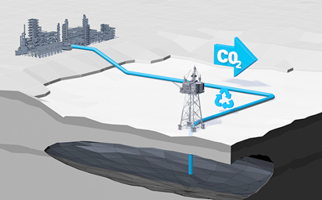For decades, the UK North Sea has been a testbed for pioneering technologies used to produce billions of barrels of North Sea oil and gas, underpinning the UK’s energy security. Innovative technologies will also pave the way for the UK's transition to net zero, helping cut emissions from North Sea oil and gas operations and supporting the growth of emerging industries such as carbon storage (CS) and hydrogen.
In support of our strategy, the NSTA has a role in the development and deployment of technologies which support energy security and emissions reduction.
We gather information from operators about the technologies they have already installed and their efforts to identify solutions which could enhance operations in future.
This information is collated and analysed to create insights for the benefit of the operators and their supply chain and is published in the NSTA’s annual Technology Insights Report to raise awareness of technologies which are having a positive impact and to accelerate their deployment across the North Sea.
This consolidated view of technology deployment by operators is an important indicator of the state of the industry to meet current needs and to highlight priority areas of focus to help prepare for the future.
- 46 UKCS operators completed the annual technology survey and submitted technology plans by the end of February 2025.
- There was strong evidence of a continuing focus on technologies for the cost-efficient production of hydrocarbons and the reduction of emissions across the full project lifecycle.
Notable examples:
Drilling and well construction
-
Low-cost platform modular drilling rig systems
-
Single-lift well-to-well transfers
-
Logging-while-drilling sonic logging for top of cement identification
-
Digital well planning using AI
-
Combine wireline tool strings
-
Tubing retrievable surface controlled subsurface safety valve

Facilities design and inspections
- High frequency vibration and axial data analysis
- Cost-efficient pipelines and longer tie-backs
- Subsea gas compression and multiphase boosting
- Non-intrusive inspection technologies
- AI for risk-based inspection systems
- Controls and automation

Well intervention
- Wireless downhole surveillance technologies
- Disposable fibre-lines
- Retrofit DHSVs and ESPs
- Flexible zonal isolation solutions
- Real time slickline and coiled tubing solutions
- Water shut-off solutions

Emission reduction
- Flare gas recovery systems
- Vapour recovery systems
- Enhanced emissions monitoring – including fugitives and flare efficiency measurement
- Electrification
- Hybrid energy systems
- Emissions monitoring during wells activities

Technology survey and plans
- Operators referenced 1,280 innovative solutions in the technology section of the UKCS Stewardship Survey at the end of February 2025, and in their technology plans, up from 1,250 the previous year. Half of those technologies have been used in the field and 141 are newly reported this year.
- Solutions used by an operator on more than one asset have been counted only once. Technologies which featured in previous reports, but are now considered mainstream, are not included in this year’s edition, neither are tools which failed to progress past screening and pilots.
- Balance between technologies for new asset developments (40%) and those for asset operations (45%) the remainder is decommissioning/P&A (14%).
- Installation and topsides remains steady because of recent focus on emission reduction.
- Digital and net zero themes, which cut across all these domains, are expanding rapidly.
Number of technologies reported (UKCS operators)

Image Description Number of technologies reported (UKCS operators)
Operators’ technology uptake and sources
- Focus on active technology management among UKCS operators has increased steadily.
- Twenty-one operators are reporting more than 10 distinct technologies this year.
- Over half of the technologies (61%) are sourced directly from vendors/suppliers and this trend continues to increase this year.
- However, in 22% of the cases, operators actively partner with selected suppliers to develop solutions in partnership, and/or from joint industry projects.
- There is a consistent contribution from the NetZero Technology Centre (NZTC) in supporting and facilitating technology innovation (5% of overall technologies surveyed).
Number of technologies reported by operator
Image description - Number of technologies reported by Operator
Technology sourcing
Direct spend on technology
- Operators make a sizeable contribution to technology research and development (R&D) for UKCS needs.
- In 2025, £77m of direct R&D spend is targeted, this is comparable to previous years, but less in real terms than a decade ago (Note: These are “money of the day” values (not factored for inflation).
- The forecasted Technology Transfer spend (defined as the cost to deploy the technologies in the field) continues to increase as the direct R&D expenditure remains more constant.
- Development categories attract the largest proportion of operators technology spend (61%).
Direct spend on technology
Download
Click to on the items to download.
Download
-
2025 NSTA Technology Listing XLSX - 255kb
-
Tech Insights Consolidated Technology Needs Spreadsheet 2025 XLSX - 51kb
Click to on the items to download.







